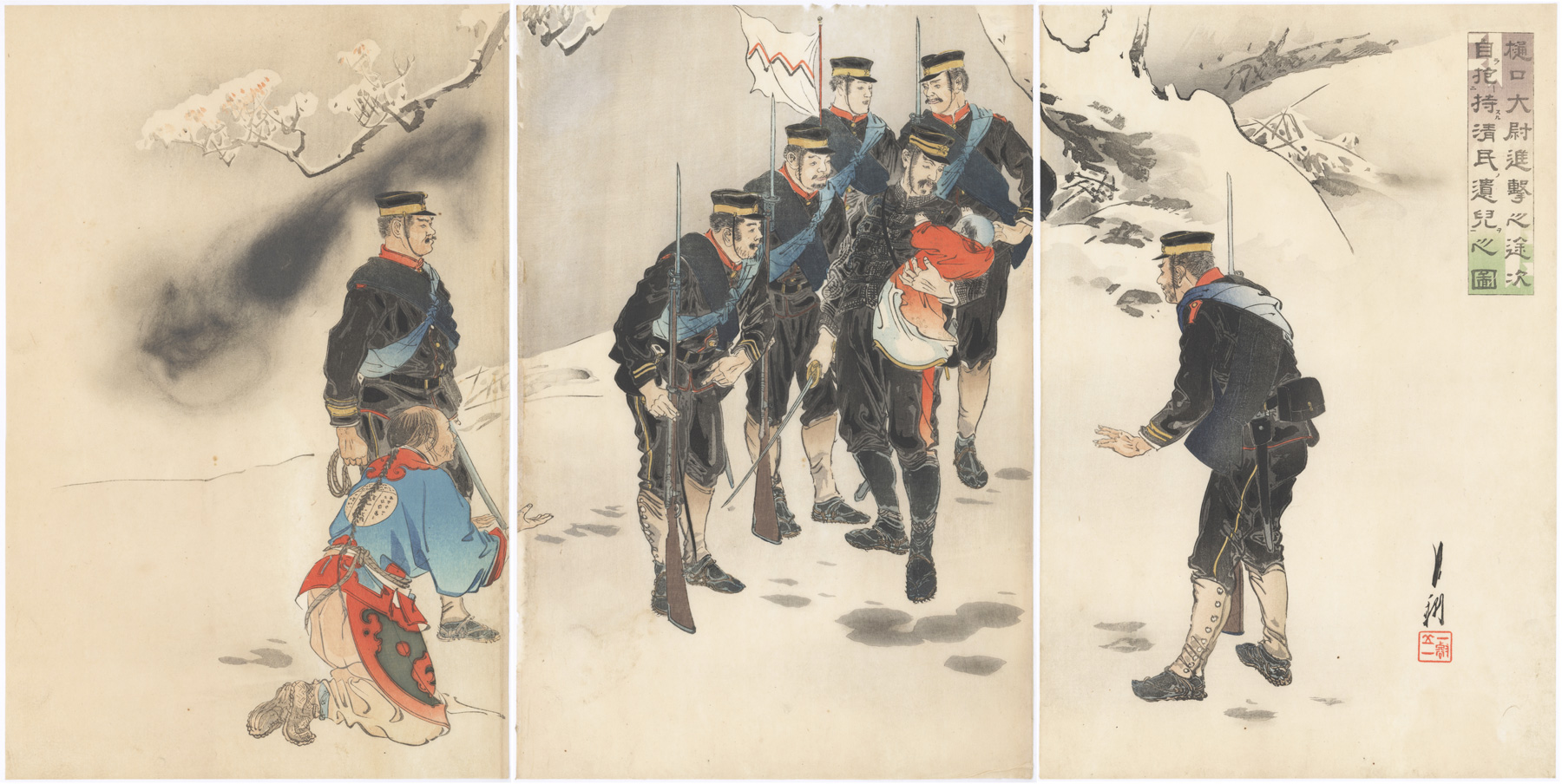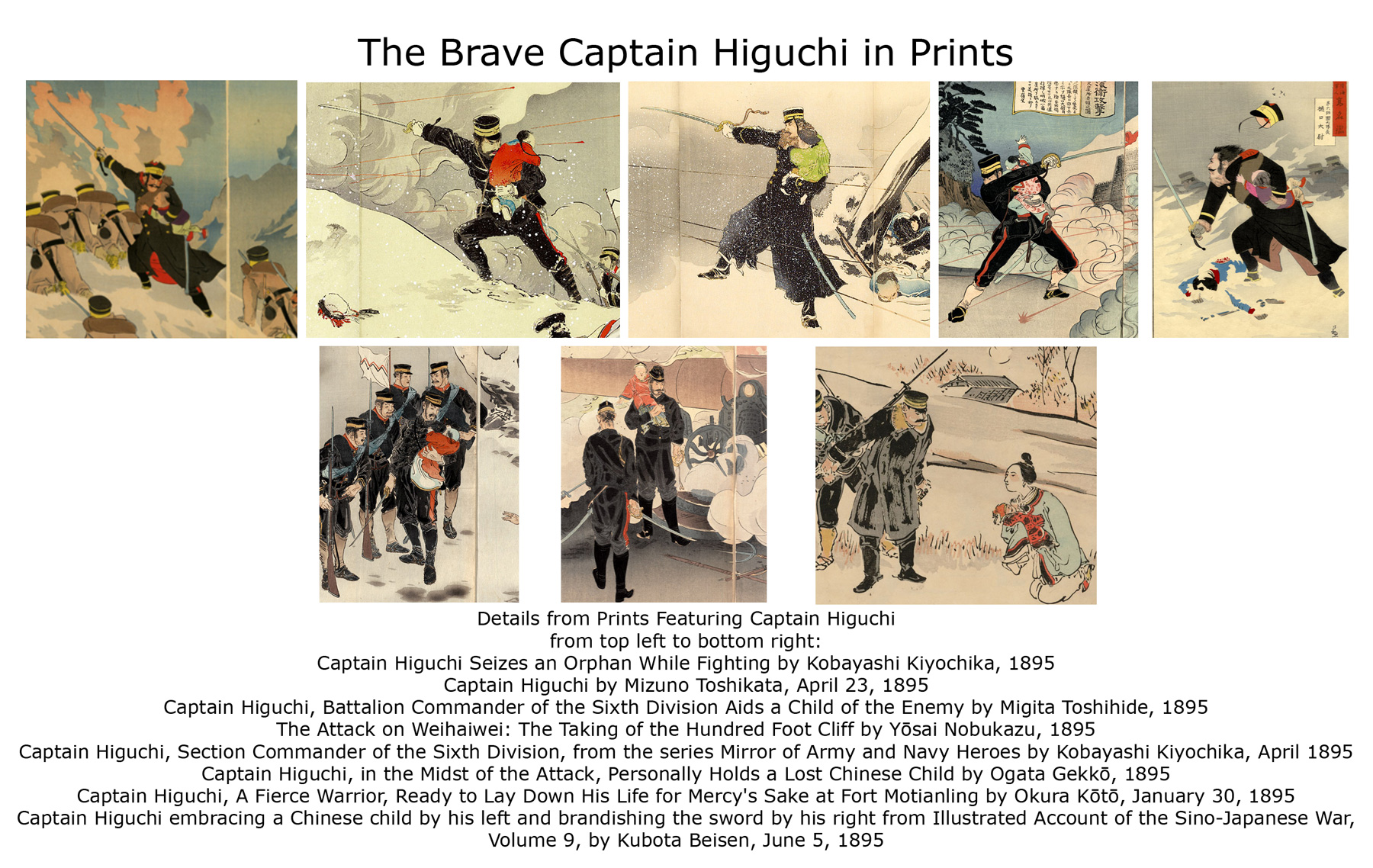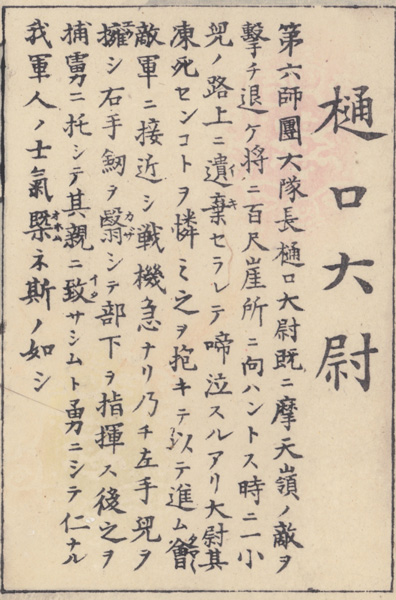About This Print
Source: MIT Visualizing Cultures https://ocw.mit.edu/ans7870/21f/21f.027/throwing_off_asia_01/compassionate_hero.html
"One of the most celebrated Japanese heroes of the Sino-Japanese War was Captain Higuchi, who reportedly rescued a Chinese infant in a crucial battle near Weihaiwei. As the story was told, Captain Higuchi heard the abandoned child crying on the battlefield, scooped him up in his left arm, and led his forces to victory flourishing his sword with his right arm. After the battle, Higuchi returned the child to his parents."
This print was one of a number of Sino-Japanese war prints on display in the "posters" section at the 1895 Nineteenth Triennial Exhibition of the Massachusetts Charitable Mechanic Association. They were contributed by the famous importer and purveyor of Japanese goods Bunkio Matsuki.1 In the report of the judges for foreign and American posters they note, "Your jury further wish to highly recommend the artistic and graphic nature of the Japanese War series of bulletins."2
1 "A Pleasing Novelty":Bunkio Matsuki and the Japan Craze in Victorian Salem, Frederic A. Sharf, Peabody & Essex Museum, 1993, p. 104.
After having destroyed and conquered the enemy at Motianling [Fort], and while pushing forward towards the "Hundred -Foot-Cliff," the battalion commander of the Sixth Brigade, Captain Higuchi, found an abandoned Chinese infant crying on the ground. Taking pity on the child and worried that it might freeze to death, he picked up the child and continued to advance. Unexpectedly, Higuchi ran into the enemy and realized that he had to fight. He then embraced the child with his left arm and raised his sword with his right arm, leading his men. Afterwards he gave the child to a Chinese prisoner who returned it to the parents. In general, [these actions] exemplify the spirit of our brave and virtuous soldiers.
The assault of the Chaopei-tsai fort was acomparatively easy task for the Japanese, for the Chinese garrison was soonvanquished and the fort readily seized by the attacking forces. After all wasover, a fine-looking Chinese woman was seen approaching the Japanese lines,having evidently lost her way. The woman was, in all probability, nothing morethan the concubine of one of the Chinese officers in the fort before itscapture; yet the Japanese took pity on her for the sake of her sex, and Lieut.-Colonel Kawamura Masanao, who was commanding a Battalion of Engineers in theSixth Division, showed her what road to take and saw that she reached in safetya house in the nearest village. A few minutes later on some of the soldiersfound a well-nourished Chinese baby boy lying on the ground, and it wassupposed that the child belonged to the woman who had just been sent beyond thelines. Pitying the little fellow, who was crying bitterly, Captain HiguchiSeizaburō,of the Sixth Division, picked him up and did his best to console the baby. Butas the young China-man refused to be comforted. Captain Higuchi called up oneof the prisoners and told him that he, the Captain, would give him his libertyif he took that baby to its parents. To this the Chinese captive, a stalwartfellow who looked as if he might have children himself, joyfully consented;but the baby refused to be separated from its Japanese friend, and cried harderthan ever when the Chinese tried to take it in his arms. So, holding the babyin his left arm while he grasped his sabre with the right, Captain Higuchimarched to the capture of the next fort, receiving at one time a bullet throughhis cap. The fort was taken in gallant style, the baby meanwhile looking on inwondering surprise at the din and uproar of the battle, perfectly content torest on the kind-hearted Captain's shoulder. When all was over this gallantofficer gave his tiny charge to some of his troopers, who bore the child insafety to a Chinese house in a village hard by.
Hana a Daughter of Japan, Gensai Murai, The Hoichi Sinbun, Tokyo, 1904
The Youth’s Companion May 26, 1898
A BABY IN BATTLE.
Among the Chinese present at one of the battles between the two Asiatic nations in the late Chinese and Japanese war, was one spectator of an unusual kind. After the capture of a small fort by the Japanese and the retreat of such of their enemies as hat not been taken prisoners, a healthy-looking Chinese baby was found by the victors, lying on the ground in their line of march. The captain of a division picked him up, and did his best to administer consolation, and presently called one of the prisoners, to whom he offered his liberty on condition that he should take the child to his parents. The captive joyously assented, but the baby raised a noisy objection. He lifted his voice on high and cried so loudly, when the attempt was made to take him from his Japanese friend, that the latter saw no resource but to submit. So, holding the baby on his left arm, while he grasped his sabre with the right, Captain Higuchi marched on to the capture of the next fort, receiving, meanwhile, a bullet through his hat. The baby looked on wonderingly while the fort was taken in gallant style, and seemed to be quite unmoved by the din and uproar of battle, so long as he could rest upon his captain's shoulder. When the fight was over, the captain gave the child to some of his troopers, who bore the little creature to a Chinese house nearby.
Print Details
| IHL Catalog | #1811 |
| Title or Description | Captain Higuchi, in the Midst of the Attack, Personally Holds a Lost Chinese Child 樋口大尉進撃之途次自抱持清民遺兒之圖 Higuchi taii shingeki no toji mizukara Seishi no ishi o hōji suru no zu |
| Artist | Ogata Gekkō (1859-1920) |
| Signature |  |
| Seal | 一嶽一叡 ichigaku ichiei* seal (see above) |
| Publication Date | July 1895 (Meiji 28) [appearing in left margin which has been trimmed from this print] |
| Publisher | Daikokuya Heikichi (Matsuki Heikichi 松木平吉) [Marks: pub. ref. 029] [appearing in left margin which has been trimmed from this print] |
| Impression | excellent |
| Colors | excellent |
| Condition | excellent - left margin trimmed to image; light soiling |
| Genre | ukiyo-e - senso-e (Sino-Japanese War) |
| Miscellaneous | |
| Format | vertical oban triptych |
| H x W Paper | 13 7/8 x 9 1/4 in. (35.2 x 23.5 cm) each sheet (Note: left sheet only 9” wide) |
| Literature | |
| Collections This Print | Museum of Fine Arts, Boston: Jean S. and Frederic A. Sharf Collection 21.1546-8,2000.183a-c, 2000.184a-c; Smithsonian Freer Gallery of Art and Arthur M. Sackler Gallery S2003.8.1787 and S1999.56a-c; The Walters Art Museum 95.864A-C |
last revision:




